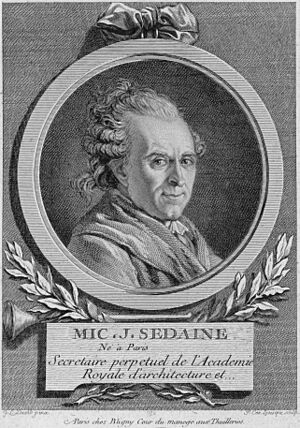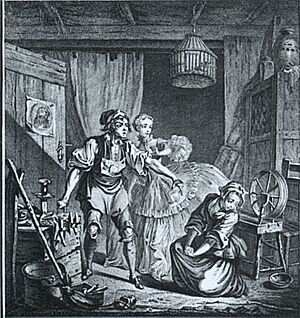Michel-Jean Sedaine facts for kids
Michel-Jean Sedaine (born June 2, 1719 – died May 17, 1797) was a talented French writer. He wrote plays (a dramatist) and stories for operas (a librettist). He was especially known for his work on opéras comiques, which are like funny musical plays. Sedaine helped these musical plays become very popular and important in France, especially before the French Revolution.
Contents
Sedaine's Early Life and Education
Michel-Jean Sedaine was born in Paris, France. His father was an architect, but he passed away when Michel-Jean was very young. This meant the family didn't have much money.
Because of this, young Sedaine started working as a mason's helper. A mason builds with stone and brick. Later, a kind architect took him on as a student. Sedaine never forgot this kindness. Years later, he was able to help the architect's grandson, a famous painter named David.
Even though he started working early, Sedaine tried hard to learn on his own. In 1750, he published a collection of short writings. This collection included fables, songs, and pastoral poems.
Writing Funny Operas (Opéras Comiques)
Sedaine was especially good at writing light operas. These were often called opéras comiques. One of his most famous works was Le diable à quatre (The Devil in Four). This play used popular songs called vaudevilles. Other composers like Philidor added more music.
Le diable à quatre was first performed in 1756. It became incredibly popular. Many different composers created music for it. It was one of the most performed comic operas in the late 1700s.
Sedaine wrote many other successful opéras comiques. Some of these include:
- Blaise le savetier (1759) with music by Philidor.
- On ne s'avise jamais de tout (1761) and Aline, reine de Golconde with Pierre-Alexandre Monsigny.
- Aucassin et Nicolette (1780).
- Richard Coeur-de-lion (1784).
- Amphitryon (1788) with André Grétry.
Two of his most important works were set to music by Monsigny:
- Le roi et le fermier (1762): This opera was special because it showed a king recognizing fairness for ordinary people. It was also longer than usual, with three acts.
- Le déserteur (1769): This opera included a full musical ending with a chorus, which was new for the time.
Sedaine's Plays for the Stage
Sedaine's work in opéra comique caught the eye of a famous writer named Diderot. Because of this, two of Sedaine's plays were performed at the important Théâtre Français.
The first play was Philosophe sans le savoir (The Philosopher Without Knowing It). It was performed in 1765 and was his longest play. The second was a lively one-act play called La gageure imprévue (The Unexpected Wager) in 1768. Both of these plays became very popular and are still considered some of the best French plays of their kind.
Sedaine also wrote two historical dramas. These were Raymond V, comte de Toulouse ou L'épreuve inutile and Maillard, ou Paris sauvé.
In 1786, Sedaine became a member of the prestigious French Academy. He also served as the secretary for architecture in the fine arts division.
Sedaine's Family Life
Michel-Jean Sedaine adopted two orphaned sisters, Anne Guéret and Louise Catherine Guéret. He cared for them as his own children. Sedaine passed away in Paris in 1797.
Sedaine's Lasting Impact
Sedaine is seen as an important figure in French theater history. He had a great understanding of how plays work on stage. He helped bring to life the ideas of Diderot about "domestic drama." This type of play focused on everyday life and family situations. Many people consider Sedaine the true founder of this style of drama in France.
His collected works, published in 1826, include a story about his life written by Ducis.




